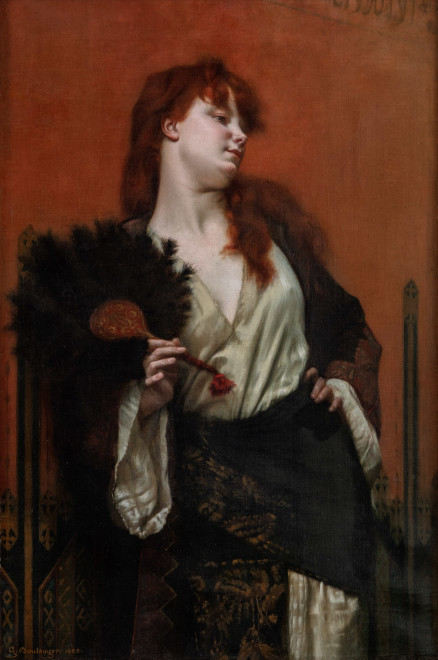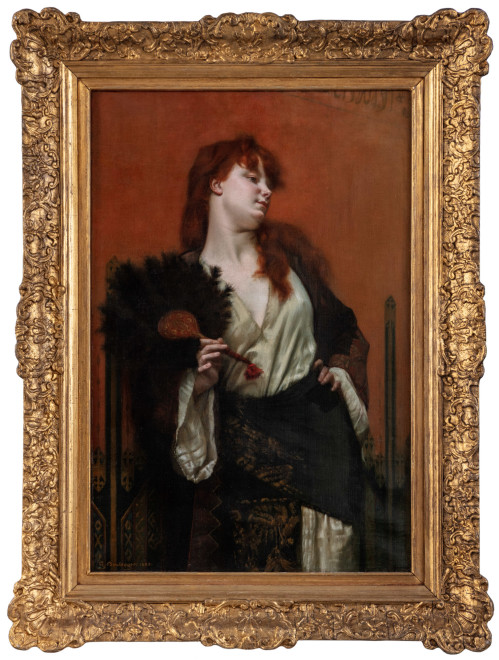Our painting was purchased by Princess Mathilde Bonaparte, niece to Napoléon III and one of France's most famous philanthropists and socialites. Testimony to her endearment to the painting, the princess made a watercolor copy of it, which she gifted to Boulanger. The painter kept the watercolor until his death.
Provenance
Mathilde Laetitia Wilhelmine Bonaparte, Princess of San Donato (1820-1904), Paris (acquired directly from the artist and sold, her sale, Galerie Georges Petit, Paris, 17-21 May 1904, lot 102, as La Captive) Galerie Bernheim Jeune, Paris (acquired at the above sale)
Sale: Hotel Drouot, Paris, 21 June 1954, lot 26
Sale: Galeria Alphaville, Rio de Janeiro, 25-26
April 2016, lot 110.
Acquired by the present owner at the above sale
Exhibited
Paris, Salon, 1884, no. 324[1]
[1] No. 324 (Captive) has been confused with no. 325 (Femme des Ouleid-Nahih) in the literature.
Literature
L'Illustration journal universel, no. 2149, vol. LXXXIII, 3 May 1884, illustrated on the cover
''Salon de 1884,'' La Lanterne : journal politique
quotidien, no. 2571, 5 May 1884, np.
L. Enault, Paris Salon 1884, Paris,
1884, n.p., illustrated, as Femme des Ouleid-Nahih.
''The Salon,'' The American register for Paris and the continent, Vol. XVI, no. 842, 24 May 1884, n.p.
Paul Arène, ''Promenade au Salon,'' La Nouvelle Revue, vol. 28, May-June 1884, p. 595-596
Roger Darx, ''Le Salon,'' Le progrès artistique, no. 317, 30 May 1884, p. 1
Charles Clément, ''Exposition
annuelle de 1884, sixième article,'' Journal
des débats, 28 May 1884, p.1.
T. Véron, Dictionnaire
Véron, ou mémorial de l'art et des artistes de mon temps, Paris, 1884, pp. 54-55, as Captive
(inacurrate description)
A. Silvestre, ''The
Captive,'' The Gallery of Contemporary Art, Philadephia,
Gebbie & co, 1885, no. 10, n.p.
M.-M. Aubrun, “Gustave Boulanger, Peintre Eclectique,” Bulletin de la Société de l'Histoire de l'Art
Français, Paris, 1986, p. 210, as La Captive.
T. Gretton, ''Un Moyen Puissant de
Vulgarisation Artistique : Reproducing Salon Pictures in Parisian
Illustrated Weekly Magazines c. 1860-c. 1895: From Wood Engraving to Half Tone Screen
(and Back),” Oxford Art Journal, no.
39, vol. 2, 25 August 2016, pp. 306, 308-309, pl. 12, 14, illustrated.
Un soir chez la princesse Mathilde une Bonaparte et les arts, Ajaccio, Palais Fesch, 2019, p.183 ill.
Catalogue note
In the nineteenth century, the countries around the Mediterranean basin attracted an increasing number of Europeans exploring, sketching, photographing, writing or just visiting. Early on, European painters developed a taste for these far-off lands known for their exoticism and raw landscapes. Contrasting Delacroix’s earlier romantic depictions, Gustave Boulanger, like Jean-Léon Gérôme, his fellow professor at the Académie des Beaux-Arts, chose to depict scenes inspired by the Orient in an ethnographical way. Commonly referred to as Orientalist, their paintings were characterized by highly detailed recognizable architectural elements, objects and landscapes. In Orientalism, strong sensations and the exotic prevailed over an accurate story. Both the public and the painters reveled in a fantasy world showcasing ferocious warriors, voluptuary bejeweled odalisques and sensual female slaves, such as depicted in our Captive.
A splendid example of an Orientalist painting, the subject of Captive is a pastiche drawn from Boulanger’s vivid imagination. In his Paris studio, working with a live model, he recreated his vision using his own sketches or photographs and authentic props he had collected over the years. The realistic black feathery ostrich fan that echoes the woman’s unbound red ethereal hair testifies to Boulanger's mastery of the genre.
Our painting, often mistaken with its Salon counterpart, Femme des Ouleid-Nahih (perhaps because the woman does not look like a captive) in the contemporary literature, was purchased by Princess Mathilde Bonaparte, niece to Napoléon III and one of France's most famous philanthropists and socialites. Testimony to her endearment to the painting, the princess made a watercolor copy of it, which she gifted to Boulanger. The painter kept the watercolor until his death.




